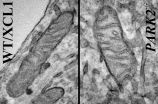Mitochondria are altered in human cell model of Parkinson's disease
Buck Institute research provides tool for testing of potential therapeutics
2015-04-02
(Press-News.org) Based on research in fruit flies, it has long been suspected that the most common mutation linked to both sporadic and familial Parkinson's disease (PD) wreaks its havoc by altering the function of mitochondria in neurons that produce the neurotransmitter dopamine. Using stem cells derived from patients who have PD, scientist at the Buck Institute have confirmed that finding in human cells for the first time. In research published in the April 2nd early online edition of Stem Cell Reports, Buck researchers also provide a valuable tool for testing potential treatments for the progressive, incurable neurodegenerative disease.
"If we can find existing drugs or develop new ones that prevent damage to the mitochondria we would have a potential treatment for PD," said Buck faculty Xianmin Zeng, PhD, lead scientist on the study. "This is the first time we can show a real and observable change in mitochondria in human cells affected by a PD mutation," she said.
Mitochondria are energy-producing organelles found in large numbers in most cells and are necessary for life. Zeng says the Park2 mutation altered mitochondrial structure and function in dopamine producing neurons, causing them to die. Dopamine is an essential neurotransmitter which regulates movement and emotion.
The research involved making mutations in the Park2 gene in well-characterized induced pluripotent stem cell (iPSC) lines as well as generating iPSC lines from skin cells of four patients who have PD. "What we saw was extraordinary," said Zeng. "We saw the same characteristics in the dopaminergic neurons derived from patients as well as ones derived from the lines where the mutation was introduced."
The finding promises to be significant in the search for treatments for an incurable disease, which affects nearly one million Americans and causes a progressive decline in movement and muscle control. Existing drugs can ease symptoms but often cause troubling side effects over time. While using patient-specific iPSC lines has been held as a potential gold standard for testing potential therapeutics for PD, Zeng says there has always been concern that background genetic differences between patients would render the testing inconclusive for larger populations of PD patients. According to Zeng, this research addresses those concerns and paves the way for testing of compounds for PD in human cells, an activity that is underway in the Buck lab of Julie Andersen, PhD, who also studies PD.
Zeng, who receives support from the California Institute for Regenerative Medicine (CIRM), says there are up to ten mutations linked to PD. Her lab is developing human iPSC models based on mutations in Pink1, SNCA, Park7 and Lrrk2, which are those more closely implicated in PD. Zeng is also involved in research aimed at getting a stem cell derived treatment for PD ready for testing in humans.
INFORMATION:
Citation: Mitochondrial alterations by Parkin in dopaminergic neurons using Park2 patient-specific and Park2 knock-out isogenic iPSC lines
Other Buck Institute researchers involved in the study include Atossa Shaltouki, Renuka Sivapatham, Ying Pei, Akos Gerencser, and Olga Momcilovic. Mahendra S. Rao, of NxCell Science in Novato, CA, also contributed to the study. The work was supported in part by grants from the California Institute for Regenerative Medicine, TR-01856 and TG2-011155.
About the Buck Institute for Research on Aging
The Buck Institute is the U.S.'s first independent research organization devoted to Geroscience - focused on the connection between normal aging and chronic disease. Based in Novato, CA, The Buck is dedicated to extending "Healthspan", the healthy years of human life and does so utilizing a unique interdisciplinary approach involving laboratories studying the mechanisms of aging and those focused on specific diseases. Buck scientists strive to discover new ways of detecting, preventing and treating age-related diseases such as Alzheimer's and Parkinson's, cancer, cardiovascular disease, macular degeneration, osteoporosis, diabetes and stroke. In their collaborative research, they are supported by the most recent developments in genomics, proteomics, bioinformatics and stem cell technologies. For more information: http://www.thebuck.org
[Attachments] See images for this press release:

ELSE PRESS RELEASES FROM THIS DATE:
2015-04-02
BOSTON -- Pseudogenes, a sub-class of long non-coding RNA (lncRNA) that developed from the genome's 20,000 protein-coding genes but lost the ability to produce proteins, have long been considered nothing more than genomic "junk." Yet the retention of these 20,000 mysterious remnants during evolution has suggested that they may in fact possess biological functions and contribute to the development of disease.
Now, a team led by investigators in the Cancer Research Institute at Beth Israel Deaconess Medical Center (BIDMC) has provided some of the first evidence that one ...
2015-04-02
The ability to learn associations between events is critical for survival, but it has not been clear how different pieces of information stored in memory may be linked together by populations of neurons. In a study published April 2nd in Cell Reports, synchronous activation of distinct neuronal ensembles caused mice to artificially associate the memory of a foot shock with the unrelated memory of exploring a safe environment, triggering an increase in fear-related behavior when the mice were re-exposed to the non-threatening environment. The findings suggest that co-activated ...
2015-04-02
(Boston)--Using patient-derived stem cells known as induced pluripotent stem cells (iPSC) to study the genetic lung/liver disease called alpha-1 antitrypsin (AAT) deficiency, researchers have for the first time created a disease signature that may help explain how abnormal protein leads to liver disease.
The study, which appears in Stem Cell Reports, also found that liver cells derived from AAT deficient iPSCs are more sensitive to drugs that cause liver toxicity than liver cells derived from normal iPSCs. This finding may ultimately lead to new treatments for the condition.
IPSC's ...
2015-04-02
Capitalizing on a rare opportunity to thoroughly analyze a tumor from a lung cancer patient who had developed resistance to targeted drug treatment, UC San Francisco scientists identified a biological escape hatch that explains the resistance, and developed a strategy in mice for shutting it down.
In experiments that combined the drug the patient had taken with a second compound that blocks off this newly discovered resistance pathway, the researchers were able to durably wipe out cancer cells in mice implanted with cells from the drug-resistant tumor.
"Even in cancers ...
2015-04-02
CANCER RESEARCH UK scientists have discovered that a vital self-destruct switch in cells is hijacked - making some pancreatic and non small cell lung cancers more aggressive, according to research published in Cancer Cell today (Thursday)*.
The team, from the Cancer Research UK Centre at the UCL (University College London) Cancer Institute, found that mutations in the KRAS gene interferes with protective self-destruct switches, known as TRAIL receptors, which usually help to kill potentially cancerous cells.
The research, carried out in cancer cells and mice, shows ...
2015-04-02
Researchers have identified a new genetic mutation at the heart of a severe and potentially deadly seizure disorder found in infants and young children. The finding, which was reported today in the journal American Journal of Human Genetics, may help scientists unravel the complex biological mechanism behind these diseases.
"These findings allow us to open up what was, up to this point, a 'black box' and more fully understand the biological pathways associated with these disorders and why some individuals do not respond to treatment," said Alex Paciorkowski, M.D., an ...
2015-04-02
In one of the first studies to examine the potential for using municipal wastewater as a feedstock for algae-based biofuels, Rice University scientists found they could easily grow high-value strains of oil-rich algae while simultaneously removing more than 90 percent of nitrates and more than 50 percent of phosphorous from wastewater.
The findings, which are based on a five-month study at a wastewater treatment facility in Houston, are available online in the journal Algae.
"Biofuels were the hot topic in algaculture five years ago, but interest cooled as the algae ...
2015-04-02
WASHINGTON --Two new studies, published online Tuesday in Annals of Emergency Medicine, illustrate the power of social media and the Internet to promote scholarly dialogue around the world and the importance of establishing criteria for what constitutes high-quality blogs and podcasts ("Global Emergency Medicine Journal Club: A Social Media Discussion About the ADJUST-PE Trial" and "Emergency Medicine and Critical Care Blogs and Podcasts: Establishing an International Consensus on Quality").
"Our Global Emergency Medicine Journal Club creates a virtual space to allow ...
2015-04-02
Highly pathogenic avian influenza (HPAI) H5 viruses of Eurasian origin continue to circulate and evolve in North American wild birds.
The U.S. Geological Survey and U.S. Department of Agriculture published the genetic analysis of a mixed-origin HPAI H5N1 avian flu virus in the journal Genome Announcements today. This novel virus was discovered in a green-winged teal in Washington State that was sampled at the end of 2014. It is a mixed-origin virus containing genes from the Eurasian HPAI H5N8 and genes from North American low pathogenic avian influenza from wild birds. ...
2015-04-02
BUFFALO, N.Y. - Shred a document, and you can piece it back together. Burn a book, and you could theoretically do the same. But send information into a black hole, and it's lost forever.
That's what some physicists have argued for years: That black holes are the ultimate vaults, entities that suck in information and then evaporate without leaving behind any clues as to what they once contained.
But new research shows that this perspective may not be correct.
"According to our work, information isn't lost once it enters a black hole," says Dejan Stojkovic, PhD, associate ...
LAST 30 PRESS RELEASES:
[Press-News.org] Mitochondria are altered in human cell model of Parkinson's disease
Buck Institute research provides tool for testing of potential therapeutics


